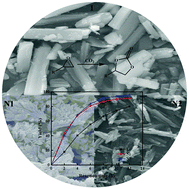当前位置:
X-MOL 学术
›
Dalton Trans.
›
论文详情
Our official English website, www.x-mol.net, welcomes your feedback! (Note: you will need to create a separate account there.)
Conversion of CO2 into cyclic carbonates by a Co(ii) metal–organic framework and the improvement of catalytic activity via nanocrystallization†
Dalton Transactions ( IF 4 ) Pub Date : 2018-01-05 00:00:00 , DOI: 10.1039/c7dt04882c Xiao-He Ji 1, 2, 3, 4, 5 , Ning-Ning Zhu 1, 2, 3, 4, 5 , Jian-Gong Ma 1, 2, 3, 4, 5 , Peng Cheng 1, 2, 3, 4, 5
Dalton Transactions ( IF 4 ) Pub Date : 2018-01-05 00:00:00 , DOI: 10.1039/c7dt04882c Xiao-He Ji 1, 2, 3, 4, 5 , Ning-Ning Zhu 1, 2, 3, 4, 5 , Jian-Gong Ma 1, 2, 3, 4, 5 , Peng Cheng 1, 2, 3, 4, 5
Affiliation

|
The Co(II) metal–organic framework (MOF) {[Co(μ3-L)(H2O)]·0.5H2O}n (1, H2L = thiazolidine 2,4-dicarboxylic acid) with rich Lewis acid sites was used as a catalyst for the conversion of CO2 and propylene oxide into propylene carbonate with a yield of up to 98% under 50 °C and 1 atm. 1 exhibited excellent reusability, which could be regenerated easily for at least five runs without a decrease in the yield. Importantly, we synthesized two types of nano-crystals (N1 and N2) of 1 with polyvinylpyrrolidone (PVP) and hexadecyltrimethylammonium bromide (CTAB) as surfactants, respectively, and investigated their catalytic properties in comparison with that of 1 in the powder phase. A significant enhancement in both catalytic efficiency and product yield was observed when 1 was nano-crystallized. This is the first investigation about the relationship between the morphology and the catalytic parameters of MOFs. The results showed a strategy for efficiently applying MOFs as catalysts towards CO2 conversion, which could also be used in other MOF-catalyzed processes.
中文翻译:

通过Co(ii)金属-有机骨架 将CO 2转化为环状碳酸酯,并通过纳米结晶提高了催化活性†
联合(II)的金属-有机骨架(MOF){[CO(μ 3 -L)(H 2 O)]·0.5H 2 ö} Ñ(1,H 2 L =噻唑烷-2,4-二羧酸)与富含路易斯酸的位点被用作催化剂,用于在50°C和1个大气压下将CO 2和环氧丙烷转化为碳酸亚丙酯,产率高达98%。1型具有极好的可重复使用性,可以轻松再生至少五次,而不会降低产量。重要的是,我们合成了两种类型的纳米晶体(N1和N2)的1分别以聚乙烯吡咯烷酮(PVP)和十六烷基三甲基溴化铵(CTAB)作为表面活性剂,并研究了它们在粉末相中的催化性能(与1相比)。当1被纳米结晶时,观察到催化效率和产物产率的显着提高。这是关于MOF的形态与催化参数之间关系的首次研究。结果表明有效地将MOF用作催化剂以实现CO 2转化的策略,该策略也可用于其他MOF催化的过程。
更新日期:2018-01-05
中文翻译:

通过Co(ii)金属-有机骨架 将CO 2转化为环状碳酸酯,并通过纳米结晶提高了催化活性†
联合(II)的金属-有机骨架(MOF){[CO(μ 3 -L)(H 2 O)]·0.5H 2 ö} Ñ(1,H 2 L =噻唑烷-2,4-二羧酸)与富含路易斯酸的位点被用作催化剂,用于在50°C和1个大气压下将CO 2和环氧丙烷转化为碳酸亚丙酯,产率高达98%。1型具有极好的可重复使用性,可以轻松再生至少五次,而不会降低产量。重要的是,我们合成了两种类型的纳米晶体(N1和N2)的1分别以聚乙烯吡咯烷酮(PVP)和十六烷基三甲基溴化铵(CTAB)作为表面活性剂,并研究了它们在粉末相中的催化性能(与1相比)。当1被纳米结晶时,观察到催化效率和产物产率的显着提高。这是关于MOF的形态与催化参数之间关系的首次研究。结果表明有效地将MOF用作催化剂以实现CO 2转化的策略,该策略也可用于其他MOF催化的过程。


























 京公网安备 11010802027423号
京公网安备 11010802027423号